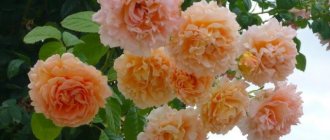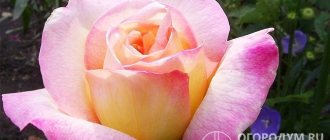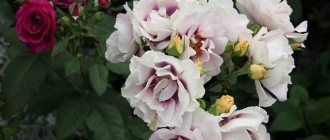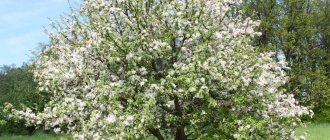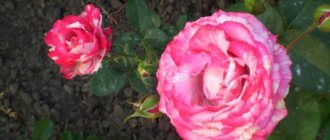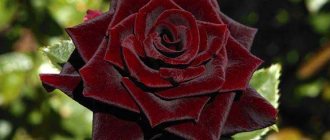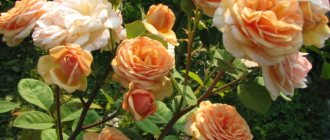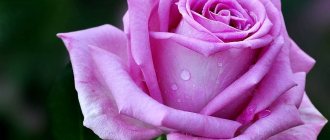Flowers with non-standard colors always arouse great interest among both professionals and amateur gardeners. One of these curious specimens is the “Abracadabra” rose, presented on the market in two color options. This spectacular floribunda attracts attention with its variegated colors and intricate patterns on the petals. The advantages of the variety include not only its striking appearance, but also long-term durability when cut, high productivity and unpretentiousness.
Rose "Abracadabra" (pictured) has an unpredictable color: each bud is a real surprise
Main characteristics
The key features of the Abracadabra varieties are given in the comparative table:
| Parameter | Characteristic | |
| Culture | Rose (Rosa L.) | |
| Variety / year of creation | Abracadabra (KORhocsel, Forkasu Porkasu) / 2002 | Abracadabra (KORamsaro, Toi toi toi!, It's Magic) / 2004 |
| Garden group | Floribunda | |
| Form | Bush | |
| Life cycle | perennial | |
| Purpose | Cutting, decorative | |
| Reproduction | Vegetative (by cuttings) | |
| Dimensions of the bush (height / width) | 0.4-0.8 m/0.4-0.6 m | 0.7-1.1/0.8-1.2 m |
| Flowering type | Reblooming | |
| Flowering period | June – October | |
| Number of flowers per stem | 1-3 pcs. | 3-7 pcs. |
| Type of flower | Terry | Dense double |
| Number of petals | 17-25 pcs. | 26-40 pcs. |
| Flower diameter | 6-8 cm | 7-10 cm |
| Petal coloring | Multicolor: burgundy, red, yellow, white | Multicolor: red, pink, white, pale yellow |
| Disease resistance | Average | High |
| Frost resistance | Up to −17 ℃ | Up to −23.3 ℃ |
| Originator, year of introduction | Kordes (Germany), 2002 | Kordes, 2014 (in Germany), 2021 (in Japan), 2021 (in Australia) |
Rules of care
In autumn, all shoots are cut to half their length.
- Water your rose at least once a week. During dry periods, watering can be increased. Avoid over-watering. It is better to water in the morning, right under the bush. Mulching the tree trunk circle will retain moisture longer and prevent weed germination.
- Loosen the soil after watering or rain after 1 - 2 days. This will increase the flow of moisture and fresh air to the root system.
- Remove weeds from the tree trunk circle. It is most convenient to do this manually immediately after watering, since any weed can be easily removed from the wet soil.
- Prune roses in the spring, before the buds awaken. This will allow you to form a beautiful crown shape. In autumn, shorten all shoots to mid-length. Carry out the procedure in dry weather, and make the cut at an angle to avoid moisture accumulation.
- Feed the rose in April-May and June-July every 8 - 9 days with complex fertilizers for roses or cow manure diluted in water.
- Carry out preventive treatment of roses with products against pests and diseases.
- Carefully cover Abracadabra for the winter, as it has low resistance to frost. Use spruce branches and agrofibre for covering.
Origin and varieties of the variety
The variety was obtained in 2002 in the famous German nursery Kordes as the result of an accidental bud mutation of the cut rose Hocus Pocus (KORpocus, 2000), which, in turn, is a sport of the hybrid tea variety Black Beauty (KORfleur, 1999).
The initial form was the rose “Hocus Pocus” (pictured left), obtained from “Black Beauty” (right) selection from the Kordes nursery.
“Abracadabra” inherited from “Hocus Pocus” the characteristic “walking” color with variegated strokes, however, unlike its parent, it turned out to be more stable (“Hocus Pocus” is not stable and over time reverses to the parent form). In 2004, Kordes breeders presented another version of the variety in a different color scheme.
The new variety is characterized by increased terry with a predominance of light pink and white shades in the color of flowers
Officially, the new product was registered only in 2014 and classified as part of the “Fantasy” collection. Over the years of its existence, Abracadabra has received many awards at international competitions, including a prestigious prize at the festival in Baden (Austria) in 2017. The variety is widely cultivated for cutting, but in a favorable climate and with proper care it grows successfully in open ground, demonstrating the abundant flowering characteristic of floribundas.
There is another variety on the world market called Abracadabra - a hybrid tea, bred in the USA (William A. Warriner) until 1991
Reproduction
Abracadabra can be easily propagated on your site through grafting, budding and cuttings.
Budding
In this way, the number of varietal bushes is increased in the second half of July or in August. Eyes can be grafted into the root collar of one or two-year-old bushes or into a strong shoot.
Graft
In the spring, you can graft “into the cleft” or “behind the bark” with cuttings cut in the fall and stored under snow or sand in basements.
Cuttings
Reproduction begins at the end of June or July. Semi-lignified annual flowering shoots are cut into cuttings. Take their middle part and divide it into segments, each of which should contain 2-3 buds. The bottom cut is made 3 millimeters below the last sheet. Then the bottom sheet is removed.
Root cuttings in greenhouses, boxes or beds in open ground. To increase the looseness and permeability of the soil, sand or peat is added to the soil. The place where the cuttings grow is shaded. You can make a frame or set up arches. The cuttings are planted in wet and dense soil. Prepared cuttings are planted obliquely to a depth of 1.5 centimeters. The leaves of adjacent cuttings should touch each other. At first, the cuttings are sprayed with warm water several times a day so that they do not have time to dry out. You can cover the cuttings with film to restrain evaporation, lightly shade them and improve survival rate. Short and thin cuttings can be covered in a glass jar.
After rooting, the cuttings are transplanted into pots and transferred for the winter to a cool, bright place where the temperature is not higher than +5 degrees. It is possible for future roses to overwinter in a greenhouse, but on condition that they are covered on top with a thick layer of leaves or spruce branches.
Description of the plant
German floribundas - varieties of "Abracadabra" have some external differences.
KORhocsel (2002) grows as a compact, upright bush. The shoots are strong, well leafy, with a small number of thorns. The foliage is round in shape with a pointed end and a jagged edge, matte, colored bright green. The dimensions of the bush are modest: on average it reaches 0.5-0.7 m in height and 0.5 m in width. This version of “Abracadabra” is also classified as a patio or border rose.
In the photo - Abracadabra bush (2002)
KORamsaro (2004) forms a vertical, moderately spreading bush of larger dimensions: up to 1 m in height and 0.8-1 m in width. Strong shoots are densely leafy, with a small number of thorns. The foliage has the same shape, but a richer dark green color and a pronounced glossy shine.
In the photo - Abracadabra bush (2004)
In warm climates and with proper care, plants of both varieties can exceed average sizes, which allows them to be grown as climbing forms - climbing forms.
Bloom
Abundant, wave-like and almost continuous flowering of the shrub is observed from the beginning of June until the first frost. In greenhouses, the plant blooms all year round and is highly productive.
The 2002 version is characterized by double cup-shaped flowers with a high center and dense velvety petals (17-25 pieces) with sharp ends. Goblet buds appear mainly one at a time, less often in inflorescences of 3-5 pieces. The average flower diameter is 6-8 cm. The petals have a combined color: a combination of strokes, stripes, asymmetrical spots and dots of red, burgundy, purple, yellow, cream and white.
The color of flowers is unpredictable - in one inflorescence there can be both plain and striped roses
Floribunda flowers, bred in 2004, are densely double, well-filled, cup-shaped with a high center. Appear one at a time or in groups of 3-7 pieces. They consist of 26-40 velvety dense petals with a wavy edge. When fully bloomed, they reach 9-11 cm in diameter. The petals have a striped color. The color scheme is dominated by pink, white, red and crimson tones. Sometimes yellow and burgundy shades appear.
Floribunda 2004 has a more stable color than its predecessor, and the likelihood of completely monochromatic flowers tends to zero
The flowers are strong, dense, resistant to rain, stay on the bush for a long time, remaining bright. When they bloom, the petals do not drop, but slowly wither on the stems. They have a pleasant but weak aroma. When cut, they retain freshness and decorative qualities for up to 16 days.
Why don't roses bloom?
- Insufficient lighting. Roses are native to the southern regions, and for good bush health, abundant flowering and rapid growth, they need to be exposed to sunlight for at least 8 hours a day.
- Presence of drafts . Rose is a heat-loving plant, and drafts have a detrimental effect on it.
- Competition with other plants . Fighting for moisture and nutrients, the rose expends the energy necessary for growth and flowering.
- Too radical pruning. After this procedure, the rose takes a long time to recover, and the onset of the flowering period is postponed.
- The presence of faded flowers on the bush . Their timely and regular removal promotes the growth of new flowering shoots. It is also necessary in the spring to cut out thin, weak and inward-growing shoots and root shoots. They compact the crown, interfere with the free circulation of air and light, and needlessly take away the strength necessary for flowering.
- Insufficient, unbalanced or excessive feeding . The plant must be fertilized correctly.
- Aging of the bush . In the spring, you should cut out old (more than 3 years old) shoots that are no longer capable of producing abundant flowering. Young branches will grow in their place.
Specifics of cultivation and agrotechnical recommendations
Both varieties of the variety are intended primarily for growing in greenhouses for cutting, so they cannot boast of good frost resistance. It is worth noting that floribunda 2004 is better suited for growing in open ground, has higher winter hardiness and good health. In general, the variety is unpretentious, has immunity to common diseases, is responsive to fertilizing, and quickly recovers after pruning. Able to tolerate short frosts down to −23 ℃, in areas with cold climates it winters safely only with hilling and good shelter. Heat-resistant, suitable for growing in southern regions.
Experienced gardeners cultivate the variety in standard and container culture
For successful development, a perennial needs the following conditions:
- open, elevated and well-ventilated areas without strong winds and drafts;
- illuminated sunny places without prolonged darkening. In the southern regions, light partial shade is preferred;
- well-drained fertile soil (chernozem, loam) with an acidity of 5.6-6.5 pH;
- The groundwater level is at least 1 m from the soil surface.
The optimal time for planting is considered to be autumn, approximately 1 month before frost. The depth of the planting hole should be about 0.5 m, the interval between seedlings should be 0.5 m (4-5 plants per 1 m2). When planting on a site, it is important to maintain a distance of at least 1.5 m from fruit and ornamental shrubs; seedlings should not be placed near tall trees, fences and buildings.
It is recommended to soak seedlings with an open root system for 6 hours in a growth stimulator solution before planting.
Caring for bushes comes down to following standard agricultural practices:
- regular watering (10-15 liters of settled warm water at the root once a week, in drought - 2-3 times);
- loosening and weeding;
- fertilizing with fertilizers during the growing season (depending on the development phase);
- mandatory prevention against diseases and pests;
- spring pruning;
- removing faded flowers during the season;
- autumn pruning, hilling and reliable shelter for the winter (in the south it winters with hilling, without shelter).
The reasons for poor growth and flowering can be: lack of light, drafts, excessive pruning, improper feeding, dense plantings.
In landscape design, the plant is used to design flower beds, mixborders, edgings and landscaping borders. Shrubs grown in containers decorate terraces or patios.
Good partners for variegated roses are plants with small, solid flowers of white, yellow, crimson and red colors.
For group plantings, compact bushes are placed in the foreground. They look impressive in the company of evergreen shrubs, conifers, annual and perennial grasses. Mackerel, aster, sea buckthorn, yellow acacia, cotoneaster, privet, juniper and tamarisk will be successful neighbors.
Bloom
With the right choice of planting site, Abracadabra blooms luxuriantly and abundantly almost all summer. If you plant it in the ground in the fall, then in the first summer the variety will produce buds. The rose fades before frost, and after the cold weather the flowers do not last. The exception is greenhouses, in which Abracadabra can bloom all year round.
Sometimes, in the first year of flowering, Abracadabra produces exclusively yellow buds, but you should not classify the bush as defective. Already next summer, the rose will surprise you with its bizarre flowers, among which it will be impossible to find two identical ones.
During flowering, the plant requires the same care as usual. A flowering bush should not be fed , but after complete flowering, as well as during periods of decline in flowering, Abracadabra needs fertilizer. Watering is standard. Also, as they fade, you will need to remove faded buds - this will stimulate the appearance of new ones.
If Abracadabra does not bloom, then most likely it is due to the wrong choice of location. It is necessary to protect the plant from drafts and ensure that it receives diffused sunlight. If you planted a rose in the shade of trees, fences or buildings, you can’t expect flowering, it won’t happen. The problem may also be unsuitable, poor soil. There is an opinion among flower growers that this variety blooms best on black soil.
Reviews from gardeners
Natalya, 53 years old, Samara
Rosa is 5 years old, but she can’t get used to the climate. Every spring I have to prune it to zero; it’s hard to come out after wintering, although I tried different methods of covering. Maybe the place was chosen poorly. It does not bloom profusely, but the coloring is very original and unpredictable.
Ksenia, 51 years old, Ekaterinburg
My bush is 4 years old and in all that time it has never frozen, although our winters can be harsh. Overwinters with hilling. The bush is small, healthy, and blooms very beautifully: in each bloom there are completely burgundy, striped, and simply yellow flowers.
Tatyana, 47 years old, Taganrog
The most interesting thing about this rose is that every bloom is a surprise. The only drawback is low frost resistance; it freezes almost every year. But such an unusual flower can be forgiven. He rarely gets sick and recovers quickly, the main thing is to protect him from fungal diseases.
Diseases, pests and ways to combat them
In order to prevent fungal diseases, at the end of May they are sprayed with Bordeaux mixture (2-3 times with an interval of 7 days). If traces of diseases do appear on the foliage, then be sure to treat with a broad-spectrum fungicide. For pests - aphids, nematodes, spider mites, etc. - they are treated with insecticides and acaricides. The preparations acrofit and actara have proven themselves well.
The floribunda rose Abracadabra in the flowerbed is a real success, because its beauty is so unusual and spectacular. It's hard to compare, but the flowers you already have will make an exquisite setting for it.
Sources:
https://cvetnikinfo.ru/sadovye-rasteniya/rozy/chudo-selektsii-roza-abrakadabra.html https://edelstarus.ru/sadovye/rozy/4-roza-abrakadabra-abracadabra-opisanie-sorta-foto-posadka -vyraschivanie-i-uhod.html https://greensotka.ru/tsvetushchie/roza-abrakadabra.html
Place in the flower garden
Rose Abracadabra is given a special place in the flower garden, separated from other crops - rose gardens. The rose only recognizes a related neighborhood, that is, it is appropriate to plant roses of other varieties nearby, but you should not combine such an exquisite flower with small or bushy species - this will ruin the entire composition of the front garden. Low rose bushes look good in straight and symmetrical areas. You can plant roses along borders, in ridges and groups. Bicolor flowers look advantageous on green lawn plantations, where secondary flowers do not interfere with them. The basic rule when using roses in landscaping is simplicity and strictness of the planting line, single variety or selection of varieties with the same biological characteristics.
Abracadabra is beautiful even without additional decorations. Its flowers are elegant and can easily decorate any place with just their many-day blooms. Yes, a rose, like everything truly enchanting and multifaceted, requires care and constant attention. But, as they say, beauty requires sacrifice.
